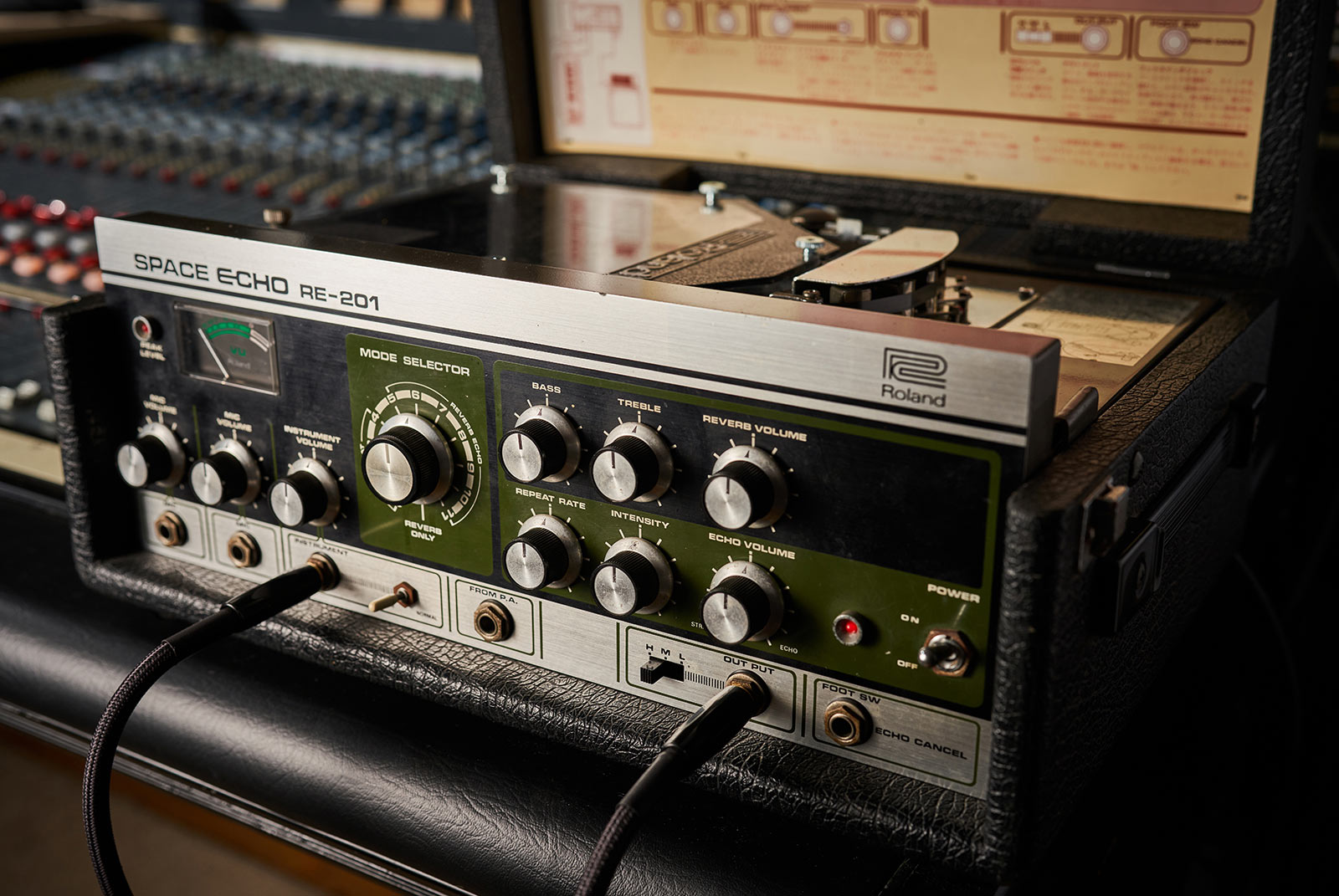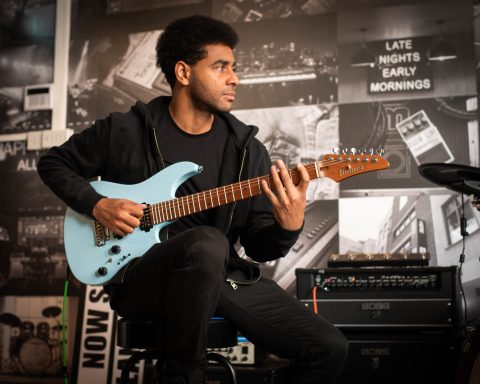Tape echo has been around since the dawn of pop music. Yet most of what we lovingly call vintage echo machines could be high-maintenance. Some of the earlier ones also used tube circuitry. While there’s much mystique surrounding tubes, the reality is that most were unreliable. That changed when Roland, only in existence for a couple of years at the time, decided to develop tape delays. Many of these classics remain in use some fifty years later. From this illustrious lineage came the legendary Space Echo.
The Space Echo Family
Roland introduced the early RE-100 and RE-200 Space Echo units in 1973. They followed these in 1974 with the legendary RE-201 Space Echo with its much longer tape loop. Indeed, it’s fair to say that the Space Echo, in particular the RE-201, was the first tape echo underpinned by serious engineering. This build quality made the unit genuinely roadworthy.
The RE-201 is the model most musicians picture when they think of a Roland Space Echo. Carefully designed, solid-state electronics reduced background noise. Plus, its long, snaking tape loop was far more durable than conventional short loops that were always under tension and prone to rapid wear. The single tape loop spooled freely into a tape chamber, with a clear plastic cover to protect the tape. Importantly, the tape stopped moving when operating the bypass footswitch. This feature greatly extended tape life.
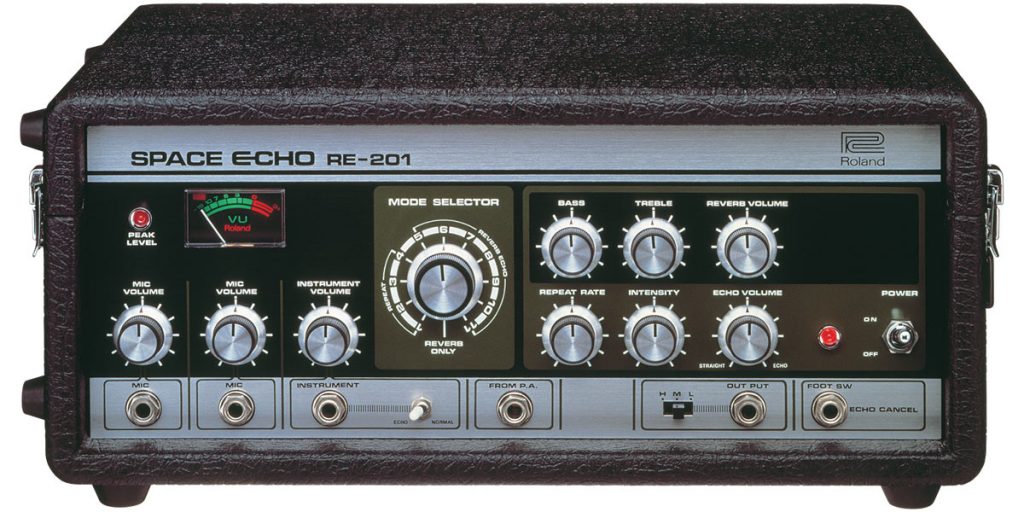
A Deep Well of Possibilities
The RE-201 featured a record head, three separate playback heads, and a variable speed motor. Users could adjust the RE-201’s delay time. They did so by altering tape speed with the Repeat Rate knob and selecting one or more playback heads using the 12-position Mode Selector.
One could also use the reverb without delay. Players could create multi-tap echo patterns by selecting multiple heads. The RE-201 boasted built-in spring reverb and the ability to feed the delayed sound back into the record head. Plus, the Space Echo could combine echo repeats with reverb. This produced a more spacious sound than tape delay alone.
"The Space Echo could combine echo repeats with reverb. This produced a more spacious sound than tape delay alone."
Recording Studio Staple
It’s no surprise that alongside its popularity with gigging musicians, the RE-201 became a recording studio staple. The unit gained such popularity due to its extremely musical sound. Echo delays melted into the background as they repeated. This helped these repeated sounds sit comfortably behind the original sound.
The Space Echo went through several iterations. 1977 saw the introduction of the RE-301. It included not only the spring reverb of the RE-201, but a chorus circuit as well. In addition, it boasted the ability to disable the erase head to build up sound-on-sound style layers. This feature brought tape delay into the world of sound design.

"The Space Echo gained such popularity due to its extremely musical sound. Delays melted into the background as they repeated."
The Birth of Chorus and BOSS
Roland pioneered the first serious chorus effects based on analog delay lines. These existed both in pedal form and integrated into the Jazz Chorus amplifier. Because of this, the RE-301’s built-in chorus had a strong pedigree. In 1976, Roland released the first BOSS-branded product: the CE-1. BOSS was established in 1979, a division of the company dedicated to making guitar-related products such as effect pedals.
For those with simpler needs, the company added the RE-150 to the line in 1979. It was essentially the same tape delay system but without the onboard reverb. In 1980, Roland unveiled the flagship RE-501. It sported balanced ins and outs, sophisticated remote control options, and offered delay, reverb, and chorus. There was also a rackmount version, the SRE-555.
"1981 saw the release of the flagship RE-501. It sported balanced ins and outs, sophisticated remote control options, and offered delay, reverb, and chorus."
Emulation and Recreation
By the time we reached the 1980s, digital technology was starting to become affordable. In the late ’80s, Roland released a digital alternative to the tape-based Space Echo: the RE-3 and the RE-5 Digital Space Echo units. Digital electronics promised greater reliability, consistent sound, lighter weight, and no tape wear. Few would argue that the RE-3 or RE-5 were perfect recreations of the original RE-series tape echo units. However, they were great-sounding and practical digital delay in their own right. As the pro version, the RE-5 featured more controls and is now extremely rare.

The RE-20 Era
Fast forward to 2007. The art of digital electronics was now sufficiently advanced. This allowed a more faithful emulation of Roland’s early tape echo units using BOSS COSM modeling. And so the BOSS RE-20 pedal, housed in the BOSS Twin Pedal case format, made its debut. COSM stands for Composite Object Sound Modeling. This is an extremely sophisticated means of sound modeling. It underpins the VG series of guitar processors, the GT-10 Guitar Effects Processor, and several other Roland/BOSS products.
The RE-20 aimed to recreate the feature set and sound of the original. It did so right down to the effects of tape saturation, the characteristics of the preamp section, and the tape transport’s wow and flutter.
"The RE-20 recreates the feature set and sound of the original down to tape saturation, characteristics of the preamp, and wow and flutter."
As digital delays became common, musicians realized that the colorations of tape-based delay were a benefit. In fact, they were what gave the delays such an organic, musical quality. Transport imperfections added a subtle but flattering modulation to the delayed sound. Tape saturation and other important factors caused repeating echoes to gradually degrade naturally.
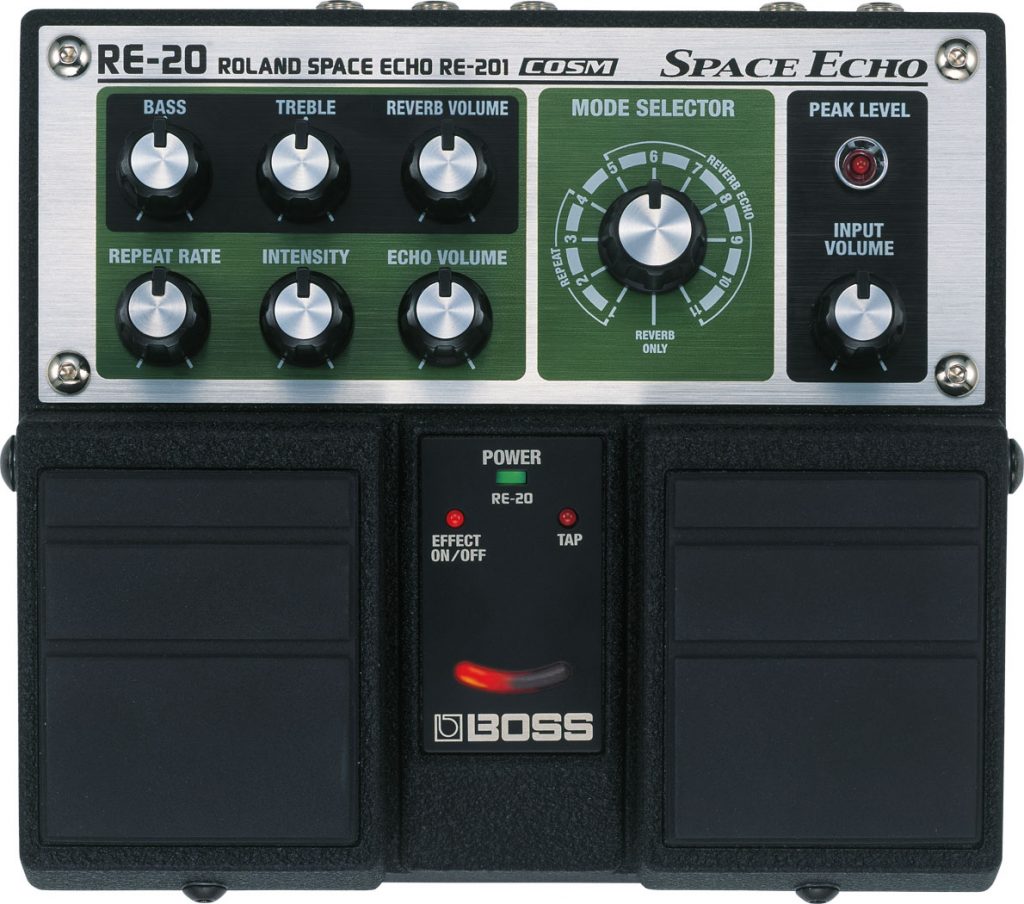
Progress Continues
The RE-20’s styling and layout mirrored the original. This included the Mode selector dial with different head configurations. Its control panel replicated all the knobs of the original. The style resembled the front panel of the RE-201. As with the original, adjusting the repeat rate control had the same effects as changing the motor speed. This resulted in pitch changes until the speed settled down again.
There were also some improvements. First off, it had a doubled repeat rate compared to the original. Stereo inputs and outputs allowed the dry stereo signal to pass through correctly as they got mixed with the delays plus a stereo reverb. There was also a dry kill switch for using the pedal in an effects send loop. Space Echo algorithms also found their way into other BOSS products like the BOSS RV-500 reverb pedal.
"With breakthroughs in processing power and modeling, BOSS decided to revisit the Space Echo, releasing the RE-202 and the compact RE-2."
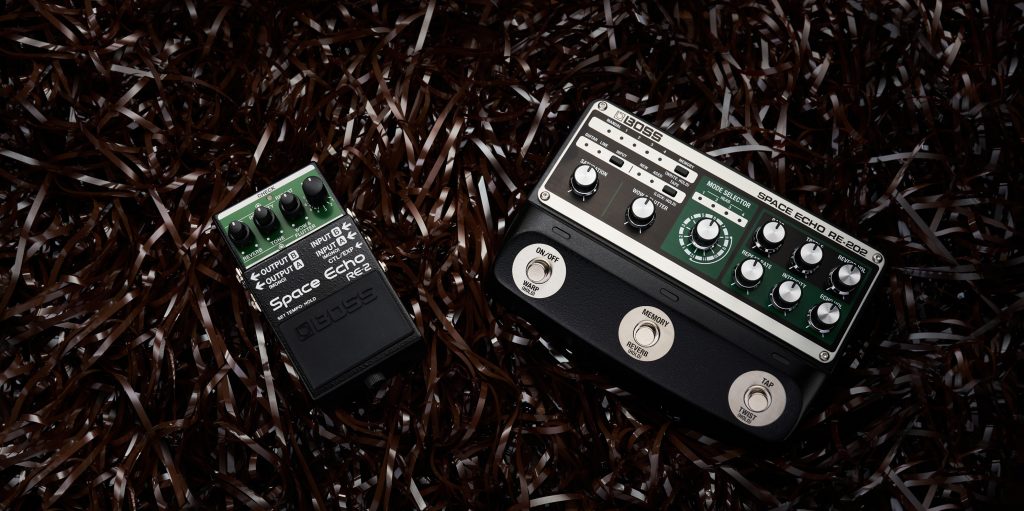
Advanced Modeling
The past decade saw tremendous advances in both processing power and modeling. With these breakthroughs in mind, BOSS decided to revisit the Space Echo, launching two new pedals in 2022, the RE-202 and the compact RE-2. Spurring this on was a renewed interest in the RE-201 sound and the continuing appetite for used RE-201 machines.
The new RE-202 and RE-2 model the tiny technological details that make tape delay sound so special in great detail. These range from the way the preamp colors the sound to the characteristics of the spring reverb, the effect of the tape path, the record/playback mechanism, motor variations, and more. The BOSS engineers referenced a number of original RE-201 units in their quest. However, this pursuit of authenticity didn’t stop them from adding features. These enhancements make the pedals even more applicable to today’s musical needs.
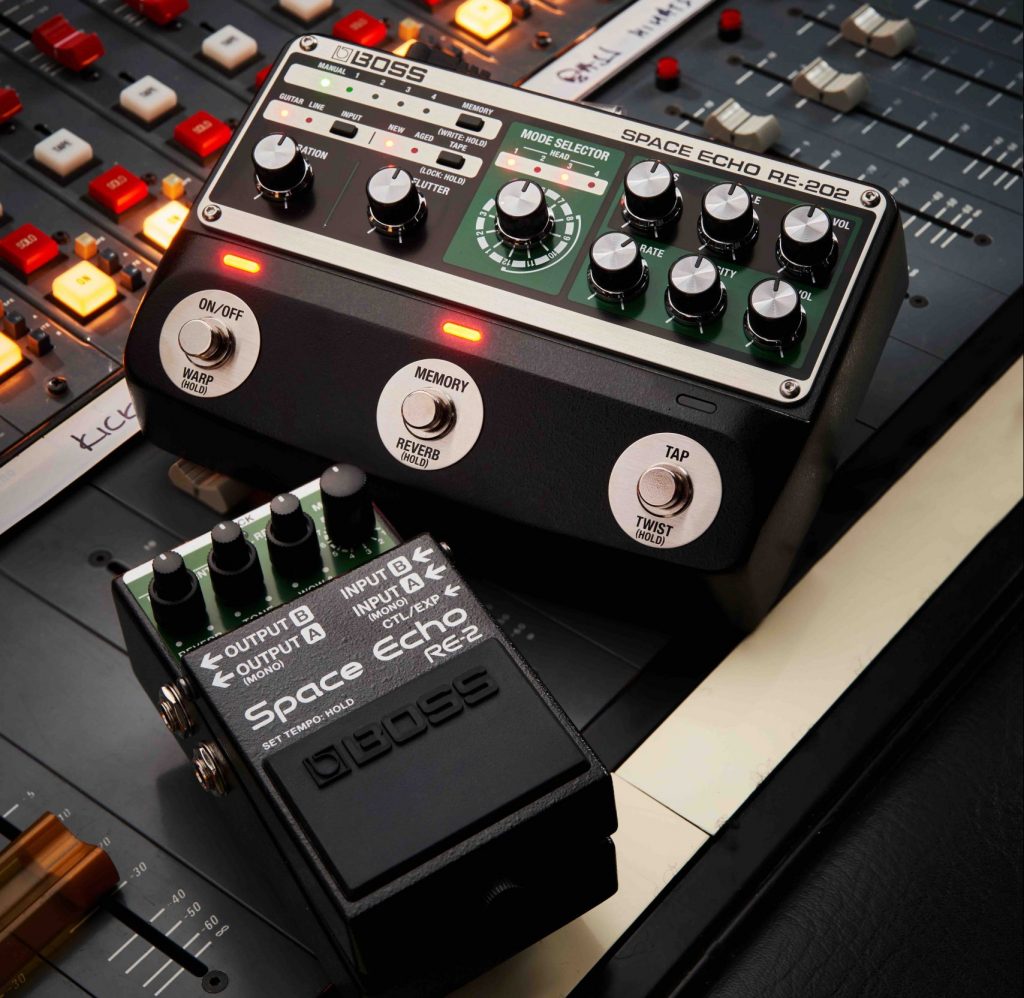
Space Echo Reborn
Today’s RE-202 has three footswitches, adding an extra replay head and doubling the maximum delay time of the original. It also allows adjustment of the amount of wow and flutter. Musicians will also enjoy the Tap Tempo function plus true stereo operation. The reverb does more than merely model the original spring. It adds the choice of hall, plate, room, and ambience reverb types giving musicians more creative options.
"The RE-202 models the tiny technological details that make tape delay sound so special in great detail."
Each RE-201 unit sounds different depending on the type and age of tape and how hard one drives the preamp. As a result, everyone has a unique idea of the perfect RE-201 sound. The RE-202 is flexible enough to allow the user to dial in tape age, preamp drive, and mechanical speed fluctuations. To make this possible, the degree of tape saturation is variable.
Additionally, input modes allow for use at line or instrument levels. Finally, the user can also choose from a pristine dry sound or one that includes the coloration of the original’s preamp circuitry.
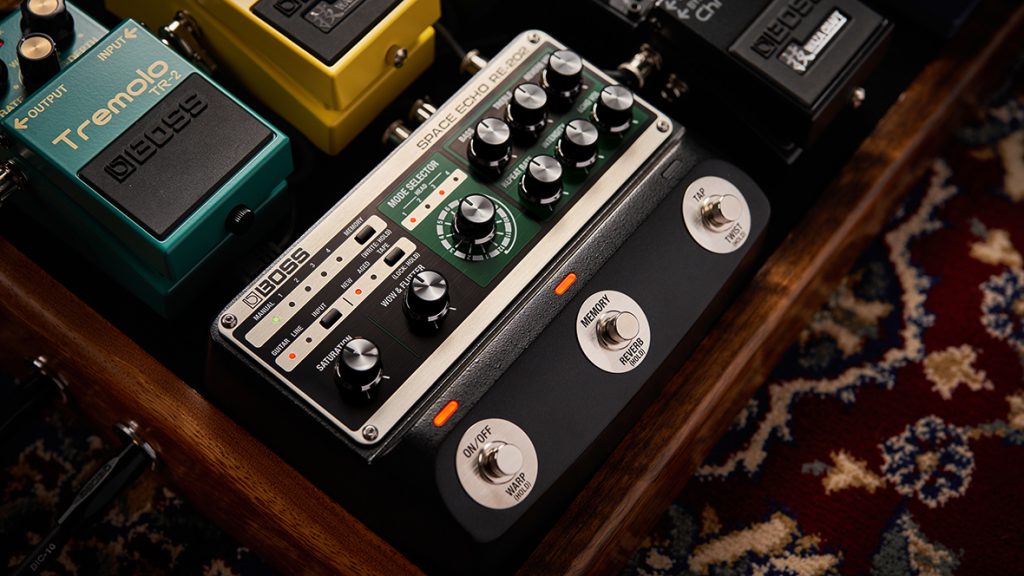
Augmenting the Past
Musicians also value the ability to recall specific settings. To achieve this, there are now four onboard memories to call up directly as alternatives to the current panel settings. In addition, there is a provision to add external footswitches, an expression pedal, or MIDI control. Call up 127 memories via MIDI program change commands.
There are also two effect modification modes known as Warp and Twist. Warp causes delays to repeat indefinitely when holding the switch. This is something that dub musicians will appreciate. Twist is also controlled by holding down a switch. It adds a speeding up, sci-fi modulation to the delays that is useful as an occasional special effect.
"Warp causes delays to repeat indefinitely when holding the switch. This is something that dub musicians will appreciate."

The Compact Alternative
There’s also an option for those with simpler needs but who demand the same sonic characteristics. The RE-2 pedal uses three dual-concentric pots and an 11-way mode selector switch in the familiar BOSS compact pedal form. This version still offers true stereo inputs and outputs. It models the three heads of the original, but omits the alternate reverbs, variable saturation, and programmability.
Users can expand functionality using footswitches to activate Twist and Tap Tempo, or an expression pedal for parameter control. The unit offers the choice of clean or preamp modeled dry sound, as well as variable wow and flutter. Players can power it with batteries or an external PSU.

"Whether in 1977 or 2022, there's still nothing quite like the sound of a Space Echo."
An Enduring Design
Many original RE-201s are still in use, fetching high prices on the used gear market. This is testimony to the excellent engineering and how great they sound. Whether in 1977 or 2022, there’s still nothing quite like the sound of a Space Echo. Thanks to the RE-2 and RE-202 pedals, musicians can experience both the sound and the control of the original, with enhanced sonic consistency, in a convenient pedal format.
Space Echo Timeline
1972
- Roland Corporation founded.
- Early pedals include AF-100, AF-60, and AD-50
1973
- RE-100 (no reverb)
- RE-200 Space Echo
1974
- RE-201 Space Echo
1975
- RE-101 (no reverb)
1977
- RE-301 Chorus Echo (reverb, tape delay, and chorus)
1979
- RE-150 Space Echo (no reverb)
1980
- RE-501 and SRE-555 (rackmount)
1982
- Chorus Echo (reverb, tape delay, and chorus)
1987
- RE-5 Digital Space Echo
1988
- RE-3 Digital Space Echo
- RE-201 Space Echo discontinued
2007
- BOSS RE-20 Space Echo RE-201 (COSM technology)
2022
- BOSS releases RE-202 and RE-2 Space Echo pedals
